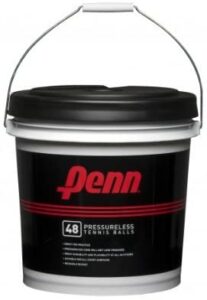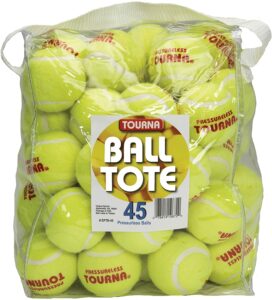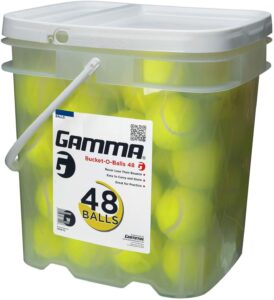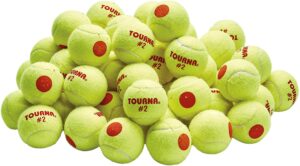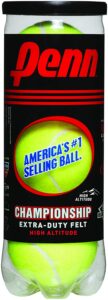As the preferred choice for tennis trainers, learners of all ages, and tennis pros getting in some extra practice, pressureless tennis balls are popular for training with and without a ball machine. The solid nature of pressureless balls gives them a longevity that can not be equaled by its pressurized or compression cousins.
Selecting the best pressureless tennis balls for your needs is easier when you have an understanding of what makes them different. There are many ball brands available, each with different pros and cons. Read on for a breakdown on what makes for the best pressureless tennis balls.
Best All-Around
These pressureless balls are the closest feeling to the real thing. They last for a very long time and are our recommended pick.
Check Today's PricePenn is a name that you have no doubt come across already. Penn is a trusted brand that prides itself on ‘100 years of excellence’ and on being the “number 1 selling ball in the USA”.
The Penn pressureless tennis ball comes in a choice of two sets, 12 balls in a mesh bag, or a bucket of 48 balls.
The bag that the 12 set comes in is a standard mesh bag that can easily be toted around in a kit bag. The drawstring bag is machine washable if needs be and can be easily hung up for storing out of the way.
The Penn pressureless ball is a good all-rounder that will see you through practice after practice, at any altitude (within reason), and in hotter areas as well as cooler climates. The fuzz of the felt is long lasting whether you drill them through a ball machine or hand serve, and the bounce appears to be everlasting.
Best For The Price
These Tourna balls give the Penn balls a run for their money and are a bit cheaper as well. An excellent option that doesn't break the bank.
Check Today's PriceThis is another bulk buy tennis ball option that comes in a useful reusable container. A total of 45 Tourna pressureless tennis balls come in a waterproof vinyl bag that zips closed.
For those of you that like your tennis balls to look the part, Tourna says these pressureless balls have a premium felt that lasts longer. The felt is more durable so should wear down less when used in a ball machine or with regular use.
Tourna balls have a heavy, solid, feel and pack more of a punch during game and practice than a pressurized one would. Thanks to their durability, these particular pressureless tennis balls seem to lend themselves well to being used in drill training to improve a player’s efficiency.
Most Premium
These balls are
Check Today's PriceThese Gamma pressureless tennis balls are suitable for all tennis court types, including indoor and outdoor. Whether you are practicing daily with your coach or playing recreationally with a friend, Gamma pressureless tennis balls will last you well. Gamma themselves proclaim that these balls will ‘never lose their bounce’.
Gamma tennis balls are raved about because of how well they work with tennis ball machines. The sturdiness of the ball means that they easily sustain being fed through and shot out of the machine time and time again. You might lose some felt covering along the way but that should have no negative effect on your practice.
That they play well from a ball machine, does not mean that you won’t reap the benefits without one as well. The durability of Gamma balls means that they give a satisfying play either way.
The Gamma bucket is a sturdy, reusable, plastic container with a lid and handle that comes filled to the brim with 48 pressureless tennis balls. Having such a sturdy container is really useful for traveling to and from training (much better than fishing around the bottom of your kit bag for rogue tennis balls). It also makes storage much easier too, just pop the bucket in the garage or utility room in between games.
Best Low Compression Tennis Balls
These low compression balls are great for beginners and kids who are working their way up to regular balls.
Check Today's PriceUnlike pressurized and pressureless tennis balls, low compression balls are suitable for absolute beginners, including small children. In fact, they are purposefully designed for tennis training.
Orange dot low compression tennis balls are designed to have 50% less bounce than a regular ball. Making them ideal for anyone getting used to hitting the ball more often and also for anyone building up their fitness levels. The low bounce gives the perfect height for a child and their slower fly speed gives plenty of opportunities for you to work on your ground stroke.
Tourna Orange Dot balls are stage 2 balls and meet the standards set by the United States Tennis Association and the International Tennis Federation. This is good news for anyone training competitively, young or old, but probably of little consequence to anyone just starting out.
Best High Altitude Tennis Balls
These pressurized tennis balls are great for those playing at high altitudes as they will retain their bounce better.
Check Today's PriceIf you are hell-bent on sticking with pressurized balls but live and play in a high altitude then you can’t go wrong with Penn Champion High Altitude Tennis Balls. These are some of the best high altitude tennis balls available. This particular Penn ball is specifically made for altitudes of 4000 feet or more and is the official ball of the USTA.
The felt covering of these high-altitude balls has been created with interlocked wool fibers which allow for a more even and hard-wearing nap. The seams are deep elastic so you can expect less cracking to occur than on your average ball. Despite this advantage, take care of your equipment by storing it in a cool, dry, environment and away from direct sunlight.
These are at the higher end of the tennis ball cost bracket which is to be expected for anything that is purposefully designed for specific environmental conditions. Penn knows you will only buy these balls if you know you need them and therefore won’t mind paying that little bit more for them.
Buying a bundle of 12 cans usually works out considerably better value for money than buying single cans of 3 at a time.
What Are Pressureless Tennis Balls?
Simply put, a pressureless tennis ball has a solid core of rubber. Whereas a standard pressurized tennis ball is filled with air. From the outside, pressureless and pressurized tennis balls look the same and you would be hard pressed to distinguish between the two types if they lay side by side on a court.
How Are Pressureless Tennis Balls Different?
Other than the solid core and the way that they are made, pressureless tennis balls are different in how they feel and how they play.
As you would expect of a ball that is solid vs a ball with a hollow core, a pressureless ball will feel heavier in the hand. This then impacts the way it plays in that you will feel that extra weight it has when you hit the ball. You might experience an extra jarring of the shoulder when you first start using these ball types since it will impact your racket with more power and require more power to return.
Pressureless balls also bounce for longer than the air-filled variety which eventually loses air and therefore loses bounce. This is one of the things that makes pressureless balls great for practicing. There will be less cause to replace your practice balls as often.
How Long Do Pressureless Tennis Balls Last?
One of the best things about pressureless balls is that they improve with age. Whereas, as we touched on already, a pressurized ball will lose its bounce, its speed, and its spin relatively quickly.
With a pressureless ball, the felt will wear down over time which only improves its speed as it gets lighter and more streamlined. The more a pressurized ball is used the quicker it will lose its air. Therefore regular use prevents them from lasting as long as the pressureless type.
Now, how long the best pressureless tennis ball will last will of course depend on how often and how hard you use them. They have been known to last up to 20 years for amateur tennis players using ball machines and storing them carefully during the off season. On the flip side, a tennis coach using a set of pressureless tennis balls for several lessons a day, 4 – 5 times a week is unlikely to have them last as long.
Pressureless vs Low Compression Tennis Balls
A huge part of learning to play tennis is growing confidence. Junior players especially need this which is why a softer hitting tennis ball is a better option. This is where compression balls come in.
As I mentioned, pressureless tennis balls are hard. Which makes sense, they are after all pretty much solid rubber. For this fact alone, they are not always favored for kids’ tennis lessons. Compression balls bounce lower than both the pressureless and pressurized types. They also fly much slower making them better suited to learners and young players.
Compression balls come in three options, levels 1, 2, or 3 to suit the level of the tennis student. Level 3 being the easiest and 1 the most like a regular tennis ball but not quite the same.
Things to Consider
Bounce
When it comes to bounce only you know what you are looking for. If you are looking for the best type of tennis balls to practice with, then the pressureless ones are a great choice. They lend themselves well to volley and stroke practice and because they don’t lose their bounce they won’t tire out before you do.
However, if you are at an advanced level and want to practice with a bounce that is similar to a competitive match ball then you might find the pressurized balls more to your bounce preference.
A pressureless ball will play consistently on all court types too. Whereas a pressurized ball tends to lose its bounce on grass and clay courts.
Compression tennis balls have varying bounce heights depending on the level. Overall they have been doctored to have a much-reduced bounce rate.
Durability
For anyone looking to invest in good tennis balls as a one off or only once a year, then pressureless tennis balls could be a fit. With even heavy use, this durable style of tennis balls tends to last past the 12 month mark. Even longer with occasional use.
Even if you are a regular player then pressureless balls have more durability than pressurized as they keep their best attributes (speed, bounce, and spin) longer.
Price
For a set of 3 pressureless tennis balls, you are looking at an average cost of around $10. best pressureless tennis balls. For better value, buy in bulk which could see you bag an average ball cost of below $1. Pressureless balls are available in large quantities and often with a bag to carry them in. Expect to spend around $40 -$50 for 40 pressureless tennis balls.
Brand
There are a number of brands and every tennis player has their preference. Over time, you may also develop a preference as your technique develops. Until then look for brands that you recognize or that the more seasoned players at your club are using.
Some of the more common brands that you might recognize are Penn, Dunlop, Gamma, and Tourna. That’s not to say that lesser known brands shouldn’t be considered. It all depends on if you want to experiment and don’t mind buying more than one type until you can find the best pressureless tennis ball type for you.
Altitude
Even the more experienced players reading this might be surprised to learn that the altitude that you play at can affect the performance of the tennis ball. So, if you are a tennis enthusiast in Fort Davis Texas, or in Bringham City in Utah, or any other town in the US that’s higher than 4000 feet you might find that using a pressureless ball helps you control the play better.
A pressurized ball in a high altitude game can seem out of control, bouncing higher than expected and whizzing past you as you scramble to return a serve. This is the effect of the altitude on the air within the ball. There are some tennis balls that are specifically designed for high altitude tennis game.
In Summary
The best pressureless tennis balls can be judged on durability and felt. The latter is an important feature for many players despite it (or the lack of it after it has worn down) having little or no negative impact on the performance of the ball.
For tennis players of any level of experience who are looking for sone knock-about balls that they can use time and time again then pressureless balls tick a lot of boxes for versatility. Start out with a brand at the lower end of the cost bracket to see if you are comfortable with the heavier weight before progressing to the pricey pressureless tennis ball options.

